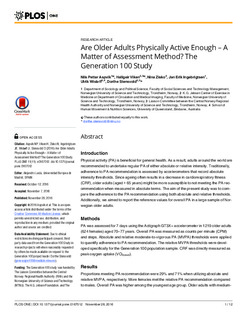| dc.contributor.author | Aspvik, Nils Petter | |
| dc.contributor.author | Viken, Hallgeir | |
| dc.contributor.author | Zisko, Nina | |
| dc.contributor.author | Ingebrigtsen, Jan Erik | |
| dc.contributor.author | Wisløff, Ulrik | |
| dc.contributor.author | Stensvold, Dorthe | |
| dc.date.accessioned | 2016-11-30T13:16:18Z | |
| dc.date.accessioned | 2017-01-18T11:37:48Z | |
| dc.date.available | 2016-11-30T13:16:18Z | |
| dc.date.available | 2017-01-18T11:37:48Z | |
| dc.date.issued | 2016 | |
| dc.identifier.citation | PLoS ONE 2016, 11(11):1-12 | nb_NO |
| dc.identifier.issn | 1932-6203 | |
| dc.identifier.uri | http://hdl.handle.net/11250/2427639 | |
| dc.description.abstract | Introduction: Physical activity (PA) is beneficial for general health. As a result, adults around the world are recommended to undertake regular PA of either absolute or relative intensity. Traditionally, adherence to PA recommendation is assessed by accelerometers that record absolute intensity thresholds. Since ageing often results in a decrease in cardiorespiratory fitness (CRF), older adults (aged > 65 years) might be more susceptible to not meeting the PA recommendation when measured in absolute terms. The aim of the present study was to compare the adherence to the PA recommendation using both absolute and relative thresholds. Additionally, we aimed to report the reference values for overall PA in a large sample of Norwegian older adults.
Methods: PA was assessed for 7 days using the Actigraph GT3X+ accelerometer in 1219 older adults (624 females) aged 70–77 years. Overall PA was measured as counts per minute (CPM) and steps. Absolute and relative moderate-to-vigorous PA (MVPA) thresholds were applied to quantify adherence to PA recommendation. The relative MVPA thresholds were developed specifically for the Generation 100 population sample. CRF was directly measured as peak oxygen uptake (VO2peak).
Results: Proportions meeting PA recommendation were 29% and 71% when utilizing absolute and relative MVPA, respectively. More females met the relative PA recommendation compared to males. Overall PA was higher among the youngest age group. Older adults with medium- and high levels of CRF were more physically active, compared to those with the lowest levels of CRF.
Conclusion: This is the first study to compare adherence to PA recommendation, using absolute and relative intensity thresholds among older adults. The present study clearly illustrates the consequences of using different methodological approaches to surveillance of PA across age, gender and CRF in a population of older adults. | nb_NO |
| dc.language.iso | eng | nb_NO |
| dc.publisher | Public Library of Science | nb_NO |
| dc.rights | Navngivelse 4.0 Internasjonal | * |
| dc.rights.uri | http://creativecommons.org/licenses/by/4.0/deed.no | * |
| dc.title | Are Older Adults Physically Active Enough - A Matter of Assessment Method? The Generation 100 Study | nb_NO |
| dc.type | Journal article | nb_NO |
| dc.type | Peer reviewed | nb_NO |
| dc.date.updated | 2016-11-30T13:16:18Z | |
| dc.source.volume | 11 | nb_NO |
| dc.source.journal | PLoS ONE | nb_NO |
| dc.source.issue | 11 | nb_NO |
| dc.identifier.doi | 10.1371/journal.pone.0167012 | |
| dc.identifier.cristin | 1405719 | |
| dc.description.localcode | © 2016 Aspvik et al. This is an open access article distributed under the terms of the Creative Commons Attribution License, which permits unrestricted use, distribution, and reproduction in any medium, provided the original author and source are credited. | nb_NO |

